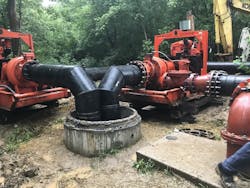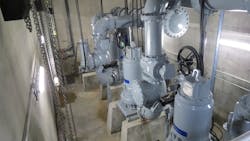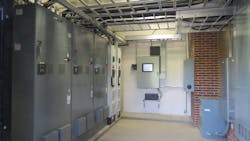Pump Station Upgrade Reduces Sewer Overflows, Improves Efficiency
Nazmul Zaman is senior applications engineer with Xylem Inc. Zaman has a Bachelor of Science in mechanical engineering from Bangladesh University of Engineering and Technology.
Dudney Fox is a principal of FOXPE, an engineering firm in Nashville, Tennessee, that provides solutions to the water and wastewater communities. He holds a Bachelor of Science in mechanical engineering from Clemson University and a master’s in civil/environmental engineering from the University of Colorado – Boulder.
undefinedThe Turtle Park Pump Station is the largest and most critical sewer pump station in the wastewater system for the city of Oak Ridge, Tennessee. The station receives all of the combined flows from the city’s collection system that feed to the Turtle Park Wastewater Treatment Plant, representing approximately 95% of all sewer flows in the city. So when the station began experiencing frequent failures due to equipment age and limited means of station bypass, city officials knew a major overhaul was needed.
Originally built in the late 1970s with a firm capacity of 14.1 million gallons per day (mgd), the Turtle Park Pump Station was upgraded in the late 1990s to a firm capacity of 30 mgd. In lieu of replacing the 1970s pumping equipment during those initial improvements, two 15 mgd pumps were added.
But by 2017, the station had become outdated, utilizing two 40-year-old intermediate shaft-driven pumps and two direct coupled non-submersible pumps located within a dry pit. The motors, electrical distribution and control systems located on the upper floor, ranging from 20 to 40 years old, also had reached the end of their useful life and were no longer reliable.
As part of the station upgrade, the city of Oak Ridge sought to replace the obsolete systems while protecting the environment from potential releases due to high flows. Equally important to the city, was achieving a reduction in electricity usage and carbon footprint with new, more energy efficient technology.
Tight Drywell Footprint
The project team encountered multiple challenges during the design and installation phase. Most problematic was the compact configuration of the original drywell. Limited clearance between the pumps made maintenance extremely difficult. Measuring just 16 feet, 4 inches by 32 feet, 8 inches, the size of the drywell severely restricted the team’s options for pump and piping configurations, despite the need to accommodate a wide range of flows, from a minimum of 1 to a peak of 30 mgd. Additionally, the tight space meant a limited means of bypass pumping at the existing station. The electrical systems also needed to be replaced, all while maintaining service during construction.
Adding yet another challenge to the station layout, the utility requested two tiers of pump capacity – smaller pumps to accommodate dry weather flow conditions and larger pumps for wet weather flow conditions. The average daily flow requirement was 4.2 mgd with a range from 1.0 to 7.6 mgd. By providing different capacity pumps, the team could meet one of the city’s goals and provide maximum hydraulic efficiency and energy savings.
The existing suction isolation valves also required replacement, which necessitated a complete bypass of the station. Because existing bypass capabilities were limited to dry weather flow rates, the team needed a new approach to ensure no overflows occurred during the construction period.
Submersible Pumps: A Solution to Space Constraints
The city of Oak Ridge retained FOXPE as the consulting engineer on the project. FOXPE then engaged Xylem’s application engineering team to design a successful pumping solution that accomplished the utility’s goals while overcoming the station’s legacy constrictions.
Previously, the Turtle Park Pump Station had conventional dry pit pumps with long line shaft and motors located on a different floor. Xylem proposed replacing that set-up with T-installation vertical dry pit submersible pumps, which are very compact. With a submersible motor, the pumps can be installed under flood level of the station, allowing them to run even if the station gets flooded.
Xylem also selected Flygt NT3356 and NT3315 submersible pumps to meet the station’s need to be more flexible and efficient. The two smaller capacity NT3315 pumps are now used during dry weather without compromising the station’s efficiency, while the three larger N3356 capacity pumps can run during wet weather and peak flow conditions.
The use of two different pump sizes presented a challenge for FOXPE in terms of piping design, but the compact nature of the Flygt pumps allowed the engineer to fit the modern, efficient design into the existing footprint. Ultimately, the project team was able to fit five new dry pit submersible pumps and associated piping in a space that had only accommodated four previously.
Weather further complicated the project, with the team executing the entire upgrade during a period of repeated heavy rainfall in one of the wettest years on record for the city of Oak Ridge. Despite the wet weather, the temporary bypass system was able to handle all incoming flows, and all bypasses were completed without overflows. This was especially important due to the location of the bypass immediately adjacent to East Fork Poplar Creek.
To replace the existing electrical switch gear while maintaining operation during construction, the installation team used a phased approach to ensure uninterrupted operation.
Revamped station realizes higher capacity, eliminating overflows
The project team completed the pump station upgrades in December 2018 under budget. During the first five months of operation, the pump station realized a 7% reduction in electrical consumption despite rainfall that resulted in higher than average flows. Thus, the project realized one of the city’s goals of becoming more energy efficient.
However, the greatest impact of the revamped station has been realized in the reliable and higher firm capacity of 32 mgd from the new Flygt pumps, which even exceeded the design capacity of 30 mgd.
“The station’s ability to deliver 30 mgd to the Turtle Park WWTP during high flow events is crucial to the city's efforts to reduce and eliminate overflows in the collection system,” said Tom Roberts, maintenance superintendent for the city of Oak Ridge.
Ultimately, the team achieved all of the city’s goals within the confines of the legacy station. Among the goals the project realized are mechanical reliability, protection of the environment, reduced station noise due to the new pumps being significantly quieter in the dry well and the elimination of the two shaft-driven pumps from the station’s main floor.
Renovation of the Turtle Park Pump Station was completed under budget and without any overflows due to early collaboration among key partners. As a result, the city of Oak Ridge and its residents are reaping the benefits of a robust main wastewater pump station.


